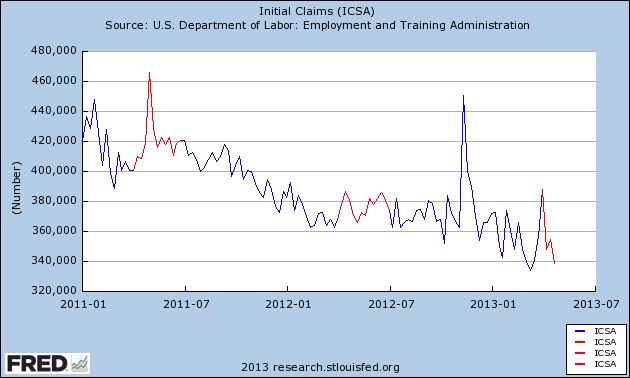- by New Deal democrat
In the rear view window, Q1 GDP was initially reported at +2.5% annualized. Once again, private growth was depressed by government austerity. March monthly data included a sharp decline in durable goods orders, which are now basically flat for a full year. New home sales increased slightly; existing home sales declined slightly. The University of Michigan confidence index increased in the second half of April, but is down month over month.
Let's start this week's look at the high frequency weekly indicators by looking at transports and consumer spending, which are the most significant changes:
Transport
Railroad transport from the AAR
- -5600 or -2.0% carloads YoY
- -1100 or -2.6% carloads ex-coal
- +1400 or +0.6% intermodal units
- -4200 or -0.8% YoY total loads
- Harpex up to 391
- Baltic Dry Index down 17 to 871
Consumer spending
- ICSC +0.8% w/w +1.9% YoY
- Johnson Redbook +1.8% YoY
- Gallup daily consumer spending 14 day average at $91 up $17 YoY
Employment metrics
Initial jobless claims
- 339,000 down 13,000
- 4 week average 357,500 down 3,750
- 92 up 1 w/w, up 1.2% YoY
Daily Treasury Statement tax withholding
- $129.5 B (adjusted for 2013 payroll tax withholding changes) vs. $136.9 B, -5.4% YoY for the last 20 days. The unadjusted result was $150.8 B for a 10.1% increase.
- $139.9 B was collected during the first 19 days of April vs. $129.1 B unadjusted in 2012, a $10.8 B or a +8.3% increase YoY.
Housing metrics
Housing prices
- YoY this week +5.8%
Real estate loans, from the FRB H8 report:
- down 15 or -0.4% w/w
- up 3 or +0.1% YoY
- +2.2% from its bottom
Mortgage applications from the Mortgage Bankers Association:
- +0.3% w/w purchase applications
- +18% YoY purchase applications
- +0.3% w/w refinance applications
Interest rates and credit spreads
- 4.54% BAA corporate bonds down -0.08%
- 1.73% 10 year treasury bonds down -0.06%
- 2.81% credit spread between corporates and treasuries down -0.02%
Money supply
M1
- +2.9% w/w
- +2.3% m/m
- +8.9% YoY Real M1
M2
- +0.4% w/w
- +0.9% m/m
- +5.6% YoY Real M2
Oil prices and usage
- Oil $93.00 up +$4.99 w/w
- Gas $3.54 down -$0.01 w/w
- Usage 4 week average YoY -1.7%
Bank lending rates
- 0.23 TED spread unchanged w/w
- 0.2000 LIBOR unchanged w/w
JoC ECRI Commodity prices
- up 0.25 to 127.12 w/w
- +1.73 YoY
The most significant indicator this week was the negative comparisons from rail loadings, even excluding coal. This was simply a very poor week, and raises a red flag. Temporary jobs, while still positive, are showing deteriorating comparisons YoY. Consumer spending as measured by the ICSC and Johnson Redbook were also quite weak. Gallup consumer spending did remain strongly positive, however.
The positives include housing prices and mortgage applications, gas prices lower than one or two years ago, an improvement in initial jobless claims, and money supply remaining positive. Credit spreads and corporate bond rates also improved.
Basically neutral indicators include shipping rates and overnight banking loans, which haven't budged, and commodities.
Tax withholding remains a question mark. It is negative after my best estimated adjustment, but relative to the last few months, this past week was relatively good.
This remains the same lukewarmly positive data we have seen since the beginning of this year, but rails and consumer spending as measured by same store sales have to be a concern that payroll tax hikes and the Sequester, as well as global weakness, are finally taking a toll. Aside from next Friday's employment report, I will be especially watching the personal savings rate (have consumers exhausted their savings?) and auto sales (will they remain below last November's peak?) in the coming week.
Have a nice weekend.































